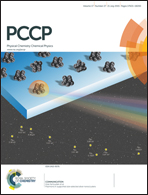Surface-enhanced Raman scattering behaviour of 4-mercaptophenyl boronic acid on assembled silver nanoparticles†
Abstract
Molecular recognition based on specific intermolecular interactions is essential for the design of sensors with high selectivity. Herein, we report the surface-enhanced Raman scattering (SERS) behaviour of 4-mercaptophenyl boronic acid (MPBA) on self-assembled silver nanoparticles and its interaction with D-glucose. It is demonstrated that the orientation and existing form of the MPBA strongly depend on the pH value of the media. The surface-immobilized MPBA can be reversibly associated with OH− in solution, along with a molecular orientation alteration. A self-condensation reaction among the OH−-associated MPBA molecules results in irreversible conversion of OH−-associated MPBA to anhydride, which may hinder the interaction between D-glucose and the B-moiety of MPBA. However, the self-condensation reaction can be diminished under optimized conditions. By taking advantage of the difference in the kinetics of dissociation of the OH−-associated MPBA and D-glucose-associated MPBA in acidic media, a proper scheme of the SERS detection of D-glucose is proposed to illuminate the spectral interference of OH−-associated MPBA, which exhibits SERS features similar to those of D-glucose-associated MPBA species. Based on those strategies, the SERS detection of D-glucose can be achieved in the physiologically-relevant concentration range.


 Please wait while we load your content...
Please wait while we load your content...